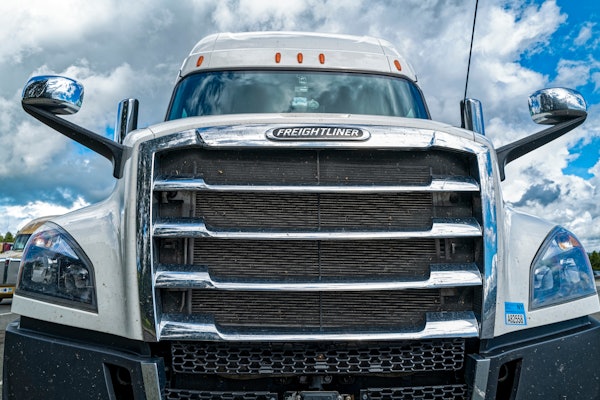If there's anything worse than wasted opportunity, it's wasted potential. Misfortune is compounded when considering how difficult it can be to find and keep good drivers and how expensive and fraught with the unknown replacing them can be.
In a webinar hosted by CCJ and Bestpass on Thursday titled "Maximizing Driver Potential," executives from Wilson Logistics, Roadrunner and Deseret Transportation shared tips on keeping drivers engaged and how fleets can invest in drivers' futures, ensuring that their time with the fleet is both long and prosperous for all parties concerned.
Did you miss the "Maximzing Driver Potential" webinar?
Invest in drivers and they’ll invest in you! This webinar covered proven ways that keep drivers engaged and loyal using driver feedback, improving drivers’ efficiency and workflow, and innovative pay models. This CCJ webinar was sponsored by Bestpass and a recorded version is now available.
It's difficult to speak of investment and not arrive at technology, especially considering how technology in transportation can improve productivity, communication and, ultimately, driver pay. However, Roadrunner Head of Technology and Operations Tomasz Jamroz said it's important to focus those investments on things with a specific purpose and a plan rather than embracing technology for the sake of technology.
The ability for technology to improve behavior "is unbelievable," he said, adding not only does it affect safety, but it's also going to affect a driver's bottom line.
"Everything comes from that visibility and that access you have to monitor that driving pattern," he said.
Prior to 2020, before Jamroz and his team began work to reshape Roadrunner's business, he said utilization of the carrier's app among its drivers was about 10%. Now, it's nearly 90%. "And with a few more added functionalities, it's going to bring us to 100%," he declared.
Wilson Logistics deployed event-based inward- and outward-facing cameras a little more than a year ago, and Chief Operating Officer Bruce Stockton said it has led to a 200% reduction in accident frequency. "Before we had the cameras," he said, "we saw damage to trailers, damage to tractors, and because it's a slip seat operation, we didn't know when or where it occurred."
Implementation of the cameras started with an education campaign, Stockton said, adding it was important that the fleet spell out what the user experience was going to be like before cameras were placed in the truck.
"We showed every driver what [the camera] was going to see, what was going to trigger it, and really understand the critical events," he said. Wilson Logistics drivers then each signed a partnership agreement that they would use the cameras, acknowledging the cameras could also help exonerate them in the event of an accident.
The end result was that average drivers became better drivers, and "better drivers became great," Stockton said, noting below average drivers left the company, "either because of positive turnover, negative turnover, or maybe they just didn't like the culture. Average drivers became better drivers because we were holding the below average drivers to a higher level of accountability."
Stockton said the fleet heard very little negative chatter about the cameras, but most opinions fell along generational lines.
"The younger generation almost expects to have that technology in the truck today. The older drivers see it an encroachment," Stockton said, "but holding the poor drivers accountable, to either improve their performance or eliminate them, [the older drivers] were fully onboard."
Growth by subtraction can feel counterintuitive, but Jamroz said sometimes it's necessary, especially when you have to reinvent your business the way Roadrunner has the last few years.
"We probably let half of our fleet go, and we did it over a very short period of time, because they were just not the right driver for us," he said. "This was a painful journey, but it was a necessary thing to do."
Once a fleet's A-team is built, the process to keep them there is ongoing.
Steven Roberts, manager of fleet operations at Deseret Transportation, the private fleet of the Church of Jesus Christ of Latter-day Saints, said his driver training program is "extended onboarding," where the carrier teaches its culture and safety philosophy with weekly briefs every Monday morning.
The fleet has a driver mentor program for new hires, but Roberts said the motor carrier has found it critical in selecting the right kind of mentor, and it's not always the highest-performing driver.
"We really have to make sure that the mentor that is assigned to the driver is a driver that is fully engaged and invested in the company and what we do," he said. "The degree of the engagement of the new driver will reflect that of the mentor, at least in the short term."
Almost all (98%) of Wilson Logistics' drivers start as students. They're assigned trainers/mentors, and they build close relationships while training together that translate into long-term mentorships and continued training opportunities, Stockton said. The fleet also has a driver advocate on staff, a 30-plus year veteran of transportation. "Every driver situation that comes up... [we] review those every day, and we respond to 100% of those unless the driver doesn't tell us how we can respond."
All three fleets agree a buddy system with the right buddies can deliver high-yield results, but building the foundation of company culture starts with the driver's first day.
"The human element is very important," Jamroz said. "We start building the culture from the first time you walk into our door."
Once the driver walks out the door and climbs into the truck, other departments have to be invested in their success too. Each Wilson Logistics fleet manager monitors between 50 and 60 drivers, and 40% of their pay is based on driver safety. "If their drivers don't perform safely, that negatively affects the fleet manager's pay," Stockton said, adding driver productivity also factors into fleet manager pay.













